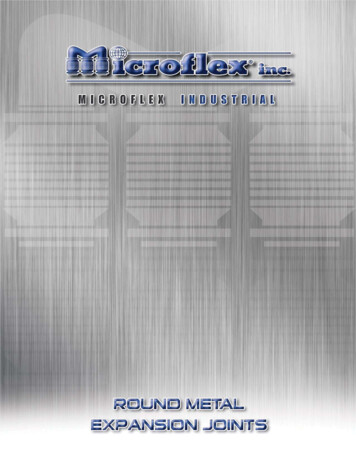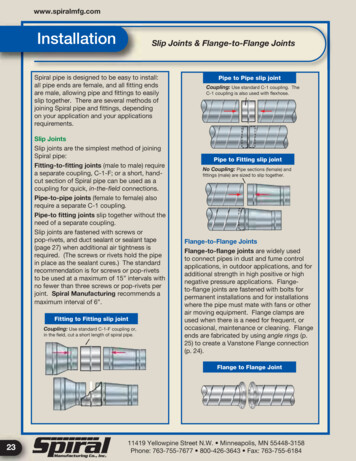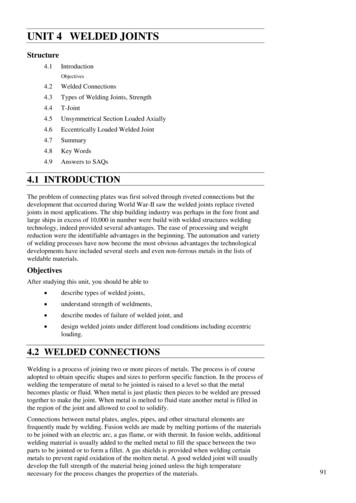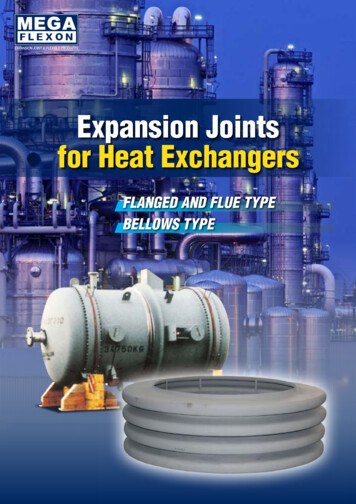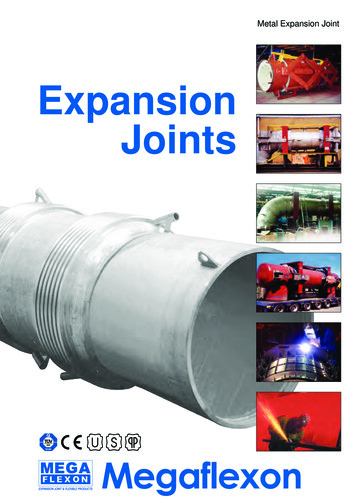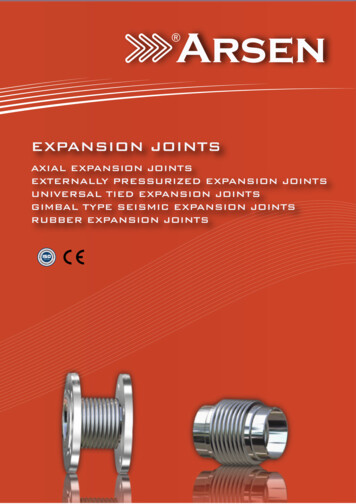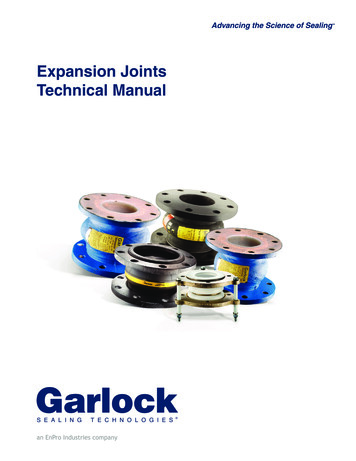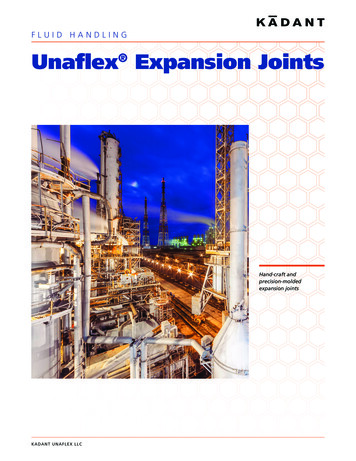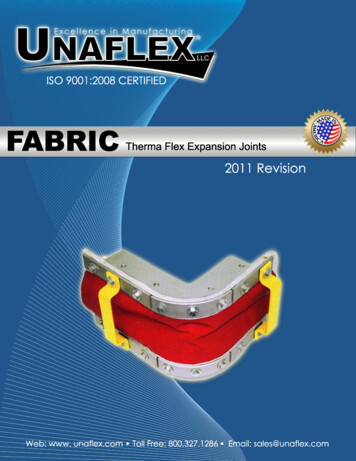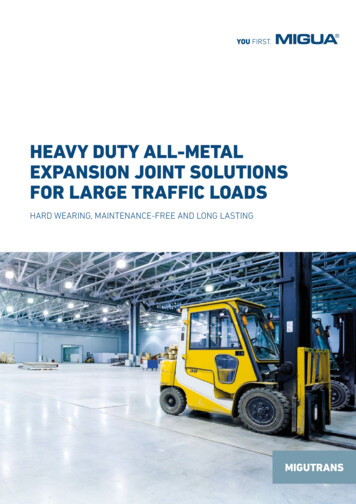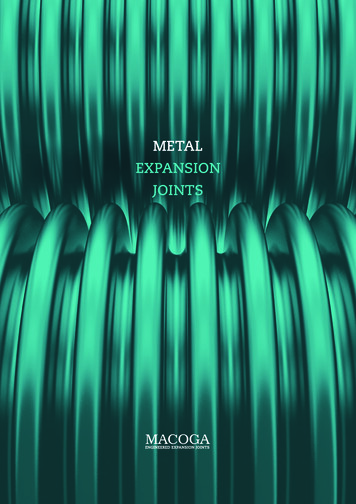
Transcription
METALEXPANSIONJOINTS
2
MACOGAMetal Expansion JointsINTRODUCTION— 5GLOBAL PRESENCE— 6FACILITIES— 7HEALTH AND SAFETY AT WORK— 10ENVIRONMENTAL PROTECTION— 11QUALITY— 12METAL EXPANSION JOINTSAdvantages and movementsQuality control and testingManufacturingMaterials— 14SERVICESDesign and calculationPacking and protectionShippingOn-site servicesPremium services— 22INDUSTRIES— 28
4
MACOGA IS AWORLDWIDE LEADINGMANUFACTUREROF EXPANSIONJOINTS AS WELL ASCOMPREHENSIVESPECIFIC SOLUTIONSIn 1960 Manuel Concheiro and hissons Mario and Carlos founded asmall company dealing with technicalproducts for serving the Spanishindustry. This space housed someof the company’s first breakthroughexpertise and big ideas that wouldlater came into the present production of ExpansionJoints.Early in the 70’s the first Expansion Joints weredesigned, manufactured and shipped from MACOGA.Throughout its more than 40-year history, MACOGAhas been a leader in developing technologies and inconverting those technologies for use in commercialmarkets. From its early days as an industrialdistributor MACOGA has successfully built upon itspioneering tradition to become a global leader.During our history, we have developed manyinnovative technologies and design and manufacturingof Expansion Joints became our area of expertise.Today MACOGA is a worldwide leading manufacturerof Expansion Joints.5
GLOBAL PRESENCEMACOGA is bringing solutions to our customers inmore than 80 countries throughout the world andhas been synonymous with international focus andworldwide presence for many years.Today, MACOGA has businesses and customers innearly every corner of the globe. Day in and day out,members of our team interact with people froman extremely diverse range of backgrounds andcountries.6
FACILITIESMACOGA headquarters and manufacturingoperation is in Ordes, La Coruña, Spain.MACOGA operates the most advanced productionfacilities and equipment specifically designed formanufacturing Expansion Joints, which guaranteeproduction efficiency and flexibility.From raw material to final product in our factory. Our100% internal production retains absolute controlover the fabrication of your Expansion Joints.We have excellent in-house facilities and machinerywhich empower our team to deliver high qualityExpansion Joints. These include:1500 m² (16,145 sq. feet) headquarters building ofoffices. 18000 m² (193,000 sq. feet) of ProductionPlant including:—— Plasma & Oxygen cutting—— Bending, rollers, presses, forming machines—— Machining equipment, CNC lathes, etc.—— Hydraulic and mechanical forming—— Shot blasting and painting cabins—— Testing benches & testing equipmentincluding X-ray bunkerBellows forming machinery:—— Hydraulic/Elastomeric forming—— Punching/Expander forming—— RollingWelding equipment:—— Automatic Submerged Arc Welding—— TIG Welding Machines—— MIG Automatic & SemiautomaticOther facilities & equipment:—— Hydraulic Presses from 2,5 to 600 Tons—— Drilling machines—— Milling/plate grinding machines up to 8 meters—— CNC Lathes—— Forklifts—— Cranes (24 cranes from 2,5 to 20 Tons)—— Own packing fabrication area and equipmentWe consistently invest in the latest technology andequipment to assure the capabilities needed to meetthe demands of the industry.7
M-Lens Expansion JointsDN5900 for a cement plant.8Tied Universal FCCU ExpansionJoint for one of the largestcrude oil processing refinery inthe north of Europe.
Sumerged Arc WeldingLateral Tied Expansion JointsDN3300 for a Power Plant.9
HEALTH AND SAFETY AT WORKEnsuring the health, safety and security ofour employees and visitors are fundamentalpriorities for MACOGA.We uphold these values in the same waythat we ensure the quality of our work: byimplementing rigorous controls through everyphase of our production processes.Our people receive training on how toperform their jobs safely, properly and incompliance with regulations.10Safety is the responsibility of every employee atMACOGA, and “zero incidents” is our foremost goal.If you are visiting us, please note that there are specificregulations relating to visitors who may enter theworkplace. We would ask that you take a few momentsto familiarize yourself with the health and safetyinformation for visitors available on our web site. Thewell-being and safety of our many customers andvisitors is our highest priority.
ENVIRONMENTAL PROTECTIONEnvironmental protection is part of our corporatecitizenship.Protecting the environment is one of MACOGA’sfundamental priorities.We believe environmental responsibility goes beyondregulatory compliance. We continually strive to meetand where practicable exceed strict safety, healthand environmental performance targets and we arecommitted to continuous improvement in all aspectsof our operations.We are committed to ensuring that our facilitieshave as low an impact as possible on local peopleand the environment.We recycle paper, plastic, packaging, batteries, etc.in our offices and all the waste generated during theproduction process receives its corresponding legallymandatory collection and recycling.The dangerous toxic waste generated (oil, picklers,paint strippers, etc.) is treated in strict accordancewith the Environmental Directives, 100% of our steelwaste is recycled and reused in other areas of theindustry, we have special zones designed to preventcertain production processes from emitting harmfuland pollutant elements into the atmosphere (paintcabin and plasma cutting machinery with highlyefficient purifying filters, X Ray bunker, etc.) andwe have emergency plans for critical situation thatimply possible environmental impact.11
QUALITYMACOGA is fully committed to a qualitymanagement process with quality as a foundationalbusiness principle. The core of the process isachieving customer satisfaction by meetingour internal and customer requirements ontime. Employee participation in a continuousimprovement effort develops reviews andimplements the quality assurance system,procedures, and practices needed to meet thehighest standards. The end goal is to continuemeeting world-class standards for the mutualbenefit of our customers and employees.Quality is the engine for improvement in ourCompany. It is the combination of actions thatincrease efficiency and output in activities andprocesses to provide added advantages to both thecompany and customers.Our vision is to create value through innovationand continual improvement. And we apply it to allareas in our company, from the purchasing of rawmaterials to the final tests and controls carriedout on each Expansion Joint, from design controland verification to the perfect efficiency of alldepartments.12MACOGA management fully supports andprovides the necessary resources for continualimplementation of the quality assurance system. Allmanagement levels participate in quality assuranceactivities incorporated into daily functionalrequirements. No product is shipped to the customeruntil its quality and conformance to customerspecifications is assured. Management assessesthe effectiveness of the quality system on a regularbasis and directs internal efforts towards continualimprovement.Quality Approvals—— ISO 9001:2008—— PED 97/23/CE. Module H—— TÜV AD 2000-Merkblatt HPO & DIN ISO 3834-2—— ASME “U” Stamp—— “NB” Certificate of Authorization—— Bureau Veritas Type Approval—— Lloyd’s Register Type Approval—— Ministry of Defense and NATOMember Countries—— GOST
FCCU Regenerator Stand Pipe Expansion Joint – Cold wall designUniversal with Pantographs. Two ply monitored Inconel 625 LCFbellows. Design temperature: 760 C (medium) 538 C (bellows)13
METAL EXPANSION JOINTSThermal growth, equipment movement, vibrationor pressure pulsation may generate movement in apiping system. When this movement is not absorbedby the piping system itself, an expansion joint is theperfect solution.An expansion joint is a device primarily formedby flexible bellows used to absorb movements ina piping system while containing pressure and amedium running through it.ADVANTAGESThe basic advantages to be gained from usingExpansion Joints are:—— Little space required for installation—— Absorption of movements in multipledirections due to their inherent flexibility—— They require no maintenance—— They reduce load and temperatureloss to a minimumThere are three basic movements that can beabsorbed by an Expansion Joint:Axial MovementAxial movement is the change in dimensional lengthof the bellows from its free length in a directionparallel to its longitudinal axis.Angular MovementAngular movement is the rotational displacement ofthe longitudinal axis of the bellows toward a point ofrotation.Lateral movementLateral movement is the relative displacement ofone end of the bellows to the other end in a directionperpendicular to its longitudinal axis.MACOGA Expansion Joints are designed,manufactured and tested in accordance with:—— E.J.M.A. (Expansion JointManufacturers Association, Inc.)—— ASME VIII, Div. I, App. 26—— EN 14917, European Standard forMetal Expansion Joints.14
QUALITY CONTROL AND TESTINGExpansion Joints are thought of as high engineeringproducts to which end our Quality ControlDepartment carefully monitors each of the differentsteps involved in the production process itself, rightfrom the moment the raw materials are purchasedup to the final controls and tests carried out on eachExpansion Joint which come off our production line.All the quality controls and tests we carry out arebased on our Quality Control Manual, approvedunder ISO 9001, as well as our Quality Procedures.All our Expansion Joints undergo a series of controlsand tests at each of the different steps in themanufacturing process and before they leave thefactory. Every Expansion Joint is submitted to a finalDimensional Check and a Leak Detection Test.The following tests can also be carried out ifrequested and/or if stipulated in the terms of acontract:Non-Destructive—— Radiographic Examination—— Liquid Penetrant Examination—— Ultrasonic Examination—— Magnetic Particle Examination—— Pneumatic Pressure Test & Leak Detection Test—— Hydraulic Pressure Test—— PMI (Positive Material Identification)—— Chemical and MechanicalAnalysis of materials used—— Spring Rate Test—— Helium Leak Detection TestDestructive—— Fatigue Life Testing—— Squirm Testing—— Meridional Yield Rupture Testing—— Burst TestThese controls and tests are carried out in line withthe procedures and guidelines approved by theQuality Control Department which certifies suchtests. These tests can be carried out, monitoredand/or certified by independent companies orclassification societies such as the following: TÜV,Lloyd’s Register of Shipping, Bureau Veritas, DetNorske Veritas, ABS Industrial Verification, etc.15
MANUFACTURINGMACOGA uses different methods for producingmetal bellows depending upon a range of differentcontributing factors (e.g. diameters, the numberof sheets used, the materials used, etc.), althoughin all cases the bellows are manufactured usingseamless tubes or metal cylinders welded along theirlength. The methods used are as follows: Expanding,Elastomeric, Hydraulic and Roll forming.Circular Expansion Joints are manufactured withsingle or multiple ply with a diameter ranging from15 to 8000 mm.Our manufacturing range includes CircularExpansion Joints of the following types:Basic Types—— Single Unrestrained—— Single Tied—— Hinged—— Universal Unrestrained—— Universal Tied—— Gimbal—— Double Hinged—— Double Gimbal—— Double Articulated—— RectangularSpecific Purposes—— Pressure Balanced—— FCCU Expansion Joints—— Thick Wall—— Flanged & Flued—— Reinforced bellows (high pressure)—— Externally Pressurized—— Jacketed—— ClamshellThe use of circular multiply bellows are the idealsolution for Expansion Joints which are exposed tohigh pressures. This system involves constructinga bellows using several thin sheets instead ofone single thick ply. This technique considerablyimproves the flexibility of the bellows, its mostimportant characteristic.There are five main advantages to be gained fromusing multiply metal bellows:—— They are highly resistant to high pressures.—— They maintain a high degree of flexibilityeven when working under high pressures.—— They have lower spring rates thanthe single thick sheet bellows.—— They have a high absorption rate formovements across short lengths thusensuring a longer working life.They guarantee important savings:—— Few units are required within anygiven system owing to their greatercapacity to absorb movements.—— The low spring rates reduce the costs incurredby anchorage and supporting structures.—— To avoid corrosion, special materials(eg. Inconel, Incoloy, etc.) can be appliedto the inner layer to protect againsttemperature and corrosion and austeniticsteel can be used to cover the remaininglayers to withstand high pressures.As well as Rectangular Expansion Joints, which,with limitless dimensions, can be supplied withdifferent convolution and corner types:—— W-shaped, Camera Corner—— V-shaped, Miter Corner (single or double)—— U-shaped, Rounded CornerRectangular Expansion Jointfor a Refinery in Europe16
High Pressure Universal Untied Reinforced Expansion Joints for awater transfer pipeline in North AfricaHinged Expansion Joints for a Combined Cycle Power Plant inthe USA17
18
In-Line Pressure Balanced MPB-I DN 4000 for a Power Plant in Europe19
MATERIALSThe essential component of an Expansion Jointresides in the degree flexibility of its bellows and thisdepends upon the design of its convolution and thematerials used during the production process.The choice of metals to be used in manufacturingthe bellows, being the basic component of theExpansion Joint, is made taking the following criteriainto account:—— Temperature resistance.—— Resistance to corrosion.—— Forming capacity.—— Mechanical characteristics.—— Resistance to fatigue.—— Flexibility when in use.Materials used in manufacturing are basicallyAustenit
Expansion Joints are: — Little space required for installation — Absorption of movements in multiple directions due to their inherent flexibility — They require no maintenance — They reduce load and temperature loss to a minimum There are three basic movements that can be absorbed by an Expansion Joint: Axial Movement Axial movement is the change in dimensional length
